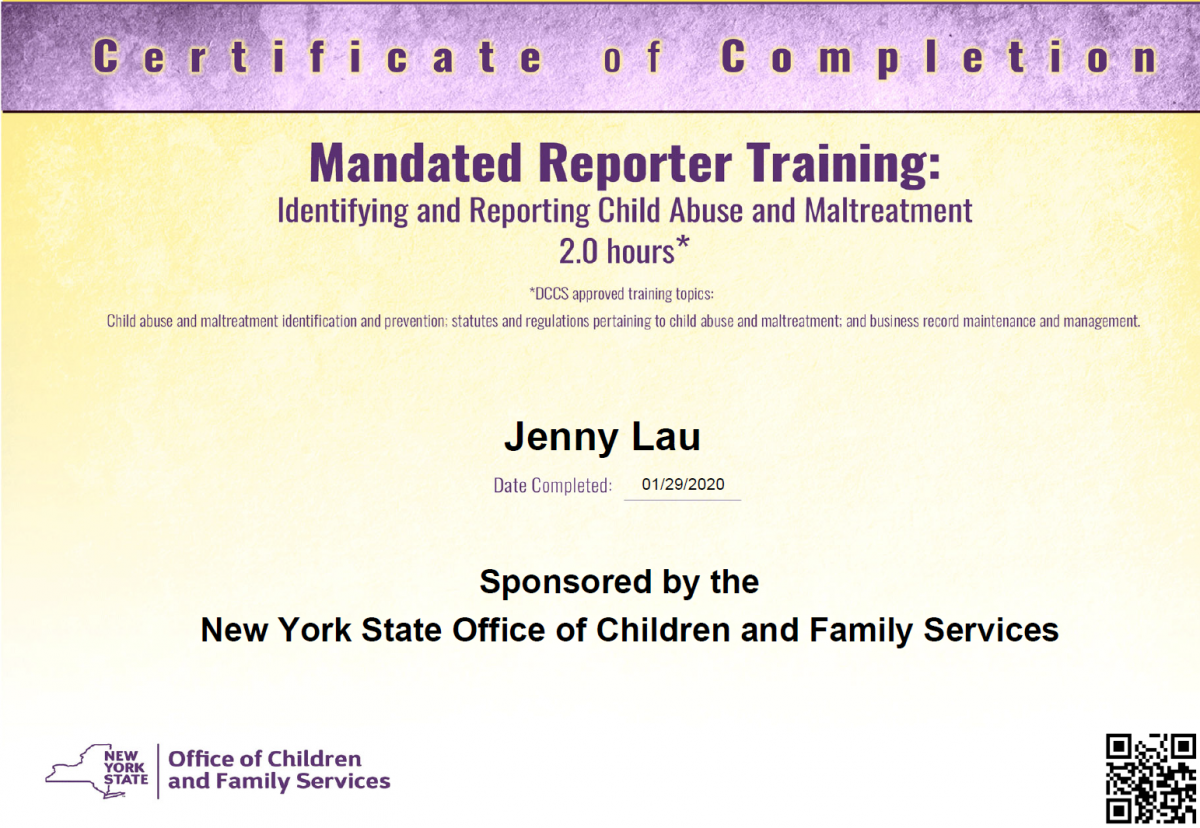Author: Jenny Lau
Previous Employment Experiences
Medical Office Assistant–Xu Z. Chen Psychiatrics PLLC (April 2016-April 2020)
Sales Executive Assistant–AV Jewelry (February 2016-April 2016)
Account Manager & Assistant Merchandiser–Masterpiece Diamonds LLC (May 2013-May 2015)
Afterschool Classroom Instructor–Immigration Social Services at P.S. 2 (September 2011-June 2012)
Acquired Skills
- Infection Control
- Head and Neck Examination
- Oral Cancer Examination
- Blood Pressure Screening
- Dietary Counseling for Prevention of Dental Decay
- Screening for Periodontal Disease
- Screening for Dental Caries
- Oral Hygiene Instruction
- Digital Radiographs (BWS, FMS, PAN)
- Pain Management (Topical and Local Anesthetics)
- Scaling and Root Planing
- Engine and Air Polishing
- Pit and Fissure Sealants
- Topical Fluoride Treatment (Gel and Varnish)
- Arestin Placement
- Community Dental Referral
- Selective Follow-up Periodontal Maintenance Therapy
Arestin Placement
According to the Arestin professional website, Arestin, minocycline 1 mg microspheres, is a concentrated, locally applied antibiotic that remains active in the pocket for an extended period of time to reduce pocket depth. The microspheres release antibiotic over time, targeting bacteria to reduce pocket depth, so gums can heal better than with scaling and root planing (SRP) alone. Arestin is not indicated for bone loss prevention or BOP. Therefore, the best candidate for Arestin treatment would have 5-7mm pocket depths.
In December 2019, I treated a patient with Arestin. He had Type III periodontitis that was stabilized with oral prophylactic treatment. The patient reported “no discomfort whatsoever” during Arestin placement. He was diligent in following aftercare instructions, and was very satisfied with the effectiveness of Arestin.
Management of Patient with Active Type III, Localized Type IV Periodontitis and Hypertension
During third semester, I treated a patient with active Type III, localized Type IV periodontitis, with radiographic evidence of severe bone loss and active carious lesions. I emphasized the importance of the patient’s need for routine dental visits and referred the patient for evaluation for periodontal treatment. I understood that the patient’s oral health condition was related to her history of limited access to dental treatment and provided the patient with home care instructions including effective brushing technique, drinking water after meals to irrigate food stuffs from the oral cavity, and rinsing with Colgate Peroxyl.
Establishing a Phase I Dental Hygiene Treatment Plan for a Patient with Major Depression, Type III Chronic Periodontitis, and Hypertension
During second semester, for periodontics class, I participated in a group project in which we established a Phase I Dental Hygiene Treatment Plan for a 63-year-old male patient, suffering from major depression. Additionally, he had Type III Chronic Periodontitis and well controlled hypertension. His medication regimen included Zoloft, amlodopine, and hydrochlorothiazide. We became familiar with dental hygiene considerations in relation to his medical conditions and compiled a write up detailing each step of the treatment plan for this patient.
Management of Patient with Dental Anxiety
During second semester, I saw my first patient who had a medical condition and heavy case type. He had just completed his chemotherapy treatment for testicular cancer one month prior to his dental hygiene appointment. He was in good health aside from his cancer diagnosis. However, I assessed that he had dental anxiety during patient interview. Throughout his treatment, I focused on minimizing the patient’s discomfort by constantly checking on his status. He was tolerant of hand scaling and ultrasonic debridement under pain management with topical anesthetic, Oraqix. The patient was receptive to home care instructions and made his best effort to maintain compliance of learned oral hygiene techniques. I was glad to see an improvement in the patient’s confidence level after completion of his dental prophylaxis treatment.
Management of Patient with Dental Anxiety
During second semester, Spring 2019, I saw my first patient who had a medical condition and heavy case type. This patient had recently received chemotherapy treatment for testicular cancer. During patient interview, I assessed that he had dental anxiety, and I focused on minimizing his discomfort throughout the course of his treatment. The patient was tolerant of hand scaling and light ultrasonic debridement under pain management with topical anesthetic Oraqix. He was receptive to home care instructions and made his best effort to maintain compliance with learned oral hygiene techniques. It was rewarding to see an improvement in the patient’s confidence level after the completion of his oral prophylaxis.
Public Health Program Planning at FDR High School
During our final semester, Spring 2020, for our Public Health course, our class was divided into groups, in which we selected a group in our community to provide dental hygiene education. My group was welcomed by FDR high school. Due to the principal’s interest, we were divided into two smaller groups, and presented to students with special needs as well as regular sophomores during their health class. All members of my group were impressed with the students’ preexisting dental hygiene knowledge and had a great time getting together outside of school to do something for our community. Below is a link to our write-up summarizing the entire project.
Service Learning Project Report






